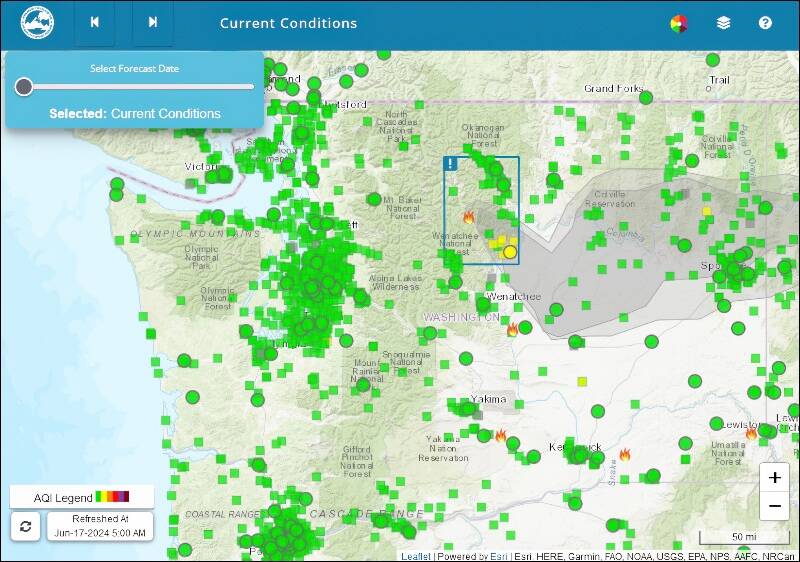The Washington Smoke Blog (wasmoke.blogspot.com) has published its 2024 smoke season projection. As part of this month’s Smoke Ready Week, the blog says: “We are expecting a quick start to wildfire season and slightly more active season than normal across Washington and British Columbia.”
Many day-to-day variables — wind, heat, and the number of wildfires and their locations — contribute to smoke conditions. Therefore, it’s impossible to say if things will get smoky on Vashon this year, but the new 2024 projection from the blog suggests it may happen.
The Washington Smoke Blog partnership includes state, county, and federal agencies and tribal governments. The blog provides a central information hub and is a good resource to bookmark for the coming months.
Getting ready means being informed about what to do if things get smoky. Public Health—Seattle & King County (PHSKC) recommends four steps during smoke conditions.
Step 1. Check the Air Quality Index (AQI). Check current conditions and forecasts at AirNow.gov, or scroll to the air quality section of your favorite weather app.
Step 2. Avoid outdoor exercise and instead move indoors when it’s smoky out. If you’re at higher risk from smoke, move indoors if the AQI is 100 or higher. This includes people who are age 18 and under, over age 65, have heart or lung conditions like asthma, and pregnant people. When the AQI is 150 or higher, everyone should move indoors. If you must be outside, an N95 mask like the ones you use to protect against COVID can also help to protect against smoke.
The Washington Department of Labor & Industries (WA L&I) updated the workplace rules regarding smoke exposure last month. If your work requires you to be outside in the smoky air, you can learn the new workplace rules here.
Step 3. Watch for symptoms of smoke exposure. Move someone inside if they have a headache, sore throat or nose, cough, burning eyes, dizziness, or wheezing. Keep inhalers and medications ready. Call 911 if someone has serious symptoms from breathing smoke, like trouble breathing or chest pain.
Step 4. Create a clean room in your house with an air purifier. To keep smoky air out, close your designated clean room’s windows, curtains, and blinds. You may need to run air conditioning or a fan to stay cool in the closed up room. If you acquired an air purifier to protect against COVID, that’s also a good tool to reduce smoke particles. Clean the unit’s prefilter regularly and replace the HEPA filter as the manufacturer recommends.
You can also make your own inexpensive smoke filter by attaching a MERV-13 furnace filter to a box fan to remove smoke particles in a designated clean room at home. Learn how by visiting here.
New developments in COVID prevention
We have come a long way since 2020, when COVID-19 emerged as a deadly global contagion.
One of the country’s early hotspots was Kirkland, where many senior care facility residents died. Back then, little knowledge was available about how the disease spread, and everything — from masks to tests to vaccines — was in short supply.
Fortunately, as recently noted by the Vashon Medical Reserve Corps (MRC), the current rate of illness from COVID remains low in King County and the respiratory virus season has wound down.
However, there likely will be another annual summer COVID peak, due in part to increased travel. Actual Vashon case counts remain unreported, but based on anecdotal evidence, the MRC believes there has been a recent uptick here.
COVID has not gone away, and scientists remain at work — publishing several encouraging reports on treatment and prevention in the last several weeks.
New 2024 COVID Vaccine in the pipeline: A national vaccine advisory committee has unanimously recommended updating COVID vaccines again this year.
The virus keeps mutating, and the U.S. Food and Drug Administration (FDA) committee selected the JN.1 Omicron subvariant as the target for the 2024 vaccine. The FDA accepted the advisory committee recommendation, and manufacturers expect to have their formulations ready by August.
The advisory committee recommendation will allow Novavax to offer its protein-based vaccine alongside the mRNA shots from Pfizer and Moderna, providing an option for those unable or unwilling to receive mRNA vaccines. Importantly, it’s recommended that people receive two doses of the Novavax vaccine if they have not received it previously. Another advisory committee on immunization practices for the Centers for Disease Control and Prevention (CDC) will meet to publish implementation recommendations on who should get the new version of the vaccines.
Combo COVID and Flu Vaccine: Moderna announced it has passed through the third-level trial with its dual-purpose vaccine combining protection against COVID and influenza (flu) in a single injection.
Pfizer and BioNTech are also testing dual vaccines. It’s hoped that the convenience of a single-injection, dual-purpose vaccine will improve the uptake of vaccinations. According to the CDC, nearly half of all adults got a flu shot this past season while less than one-fourth reported getting an updated COVID vaccine.
Moderna’s late-stage trial showed strong production of protective antibodies, equivalent to or better than the two-injection approach, suggesting benefits from the combined flu and COVID vaccine. The latest trials gathered data from 8,000 volunteers, all over 50 and half older than 64, which is particularly relevant to our Vashon population.


